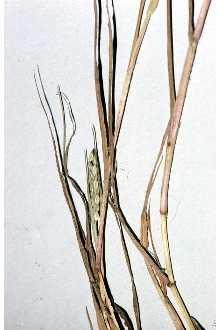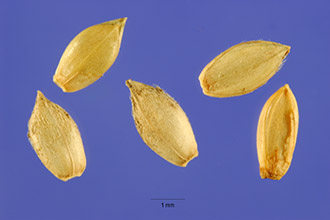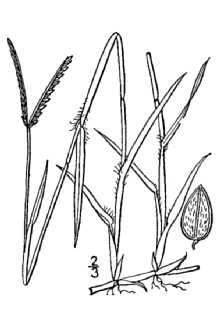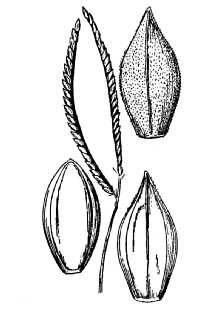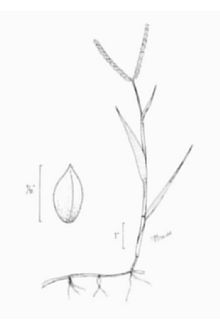Knotgrass
Scientific Name: Paspalum distichum L.
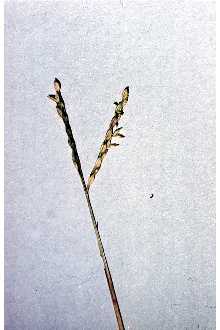
| General Information | |
|---|---|
| Usda Symbol | PADI6 |
| Group | Monocot |
| Life Cycle | Perennial |
| Growth Habits | Graminoid |
| Native Locations | PADI6 |
Plant Guide
Alternative Names
Eternity grass, Fort Thompson grass, ginger grass, joint grass, joint paspalum, saltene, salt jointgrass, salt-water couch grass, salt-water paspalum, seashore paspalum, and turfgrass. Synonyms of the scientific name are Digitaria paspaloides, Paspalum distichum var. indutum, and Paspalum paspaloides. Some botanists consider Paspalum distichum and Paspalum vaginatum as one species because they are similar in appearance and are found in similar habitats. However, the second glume at the base of the spikelet is hairy for Paspalum distichum.
Uses
Livestock: Knotgrass is valuable forage in areas of high salinity. It is recommended that knotgrass is lightly grazed and given a rest period of approximately 2 ½ to 3 months because the rooted stolons are often floating. It can be made into hay but is not suitable for silage. Ornamental Landscaping: Knotgrass is used in golf course turfs and lawns. Southern Wetland Flora USDA, NRCS, Wetland Science Institute @ Northern Prairie Wildlife Research Center Wildlife: It is grazed by many mammals and is considered a substantial source of food for ducks in Louisiana marshes. Erosion: Knotgrass is recommended in the restorations of wetlands, marshes, beaches, and stream banks. Conservation Practices: Knotgrass, because of its growth habit, potentially has application when established with certain conservation practices; however, conservation practice standards vary by state. For localized information, consult your local NRCS Field Office. NRCS practices include the following: 327-Conservation Cover; 342-Critical Area Planting; 386-Field Border; 390-Riparian Herbaceous Cover; 393-Filter Strip; 512-Pasture and Hay Planting; 550-Range Planting; 560-Access Road; 562-Recreation Area Improvement; 643-
Restoration
and Management of Declining Habitats; 644-Wetland Wildlife Habitat Management; 647-Early Successional Habitat Development/Management; 656-Constructed Wetland; 657-Wetland Restoration; 658-Wetland Creation; 659-Wetland Enhancement.
Status
Consult the PLANTS Web site and your State Department of Natural Resources for this plant’s current status, such as, state noxious status and wetland indicator values.
Description
General: Grass Family (Poaceae). It is a perennial which may be creeping or growing in clumps. The creeping stems produce roots at the nodes in which flowering stems emerge. The culms are firm and range in heights up to 1½ feet. The nodes on creeping stems are often pubescent whereas the nodes on the mat-forming stems are glabrous. The sheaths are loose and glabrous to pubescent. The blades are flat and taper to an inrolled apex. They are 2 to 6 inches long and about 1 inch wide. The flowering stem bears terminal digital racemes in 2’s or 3’s, that are up to 3 inches long. Axes are winged and glabrous with thin, dry margins. The spikelets are solitary and straw-purple in color. The first glume is rarely present. The second glume and sterile lemma are glabrous and 3-nerved. The grain is yellowish and oblong to ellipsoid.
Distribution
Knotgrass is found in both wet and well-drained areas. It frequents meadows, marshes, and ditches. It can also be found in cultivated or disturbed areas, and bordering wooded areas. It is located throughout the southeast United States, Arkansas, Texas, Oklahoma, and in the western United States. It is native to Louisiana. For current distribution, consult the Plant Profile page for this species on the PLANTS Web site.
Establishment
Adaptation: Knotgrass can tolerate high salinity and a waterlogged environment. It has no tolerance of shade. New growth starts in early March and it stays green until the first frost. Knotgrass reproduces from rhizomes, stolons, and seeds. It can be easily established by sowing stolons in damp holes. If planted in water, knotgrass will remain green throughout the year. Knotgrass may flower throughout the year. The seeds may be gathered; however, they require a period of dormancy. The seeds yield their highest germination when temperatures are between 82 to 95º F and when they receive about 16 hours of light. Ripening can be sped up with dry storage at 122º F. Also, scarring the seeds with acid may increase germination. It is not recommended to mix knotgrass seeds with cool season grass seeds. In parts of the United States where cool season grasses dominate, the warm season grasses can be taken over because they develop slower than the cool season grasses. It is also recommended that seed not be moved more than 300 miles north, 100 miles east or west, or 200 miles south of its point of origin.
Management
Tilling knotgrass on a dry surface will increase stolons to root and encourage a denser sod. Grazing also increases knotgrass. It withstands burning if water is above soil surface. The rhizomes enable knotgrass to survive fire. It sometimes can be troublesome by blocking irrigation ditches. In direct- seeded rice it is a serious weed that grows vigorously under favorable conditions. Check with the local extension service for recommended herbicides. Knotgrass has no known pests or problems. Cultivars, Improved and Selected Materials (and area of origin) Contact your local NRCS Field Office. Common seed and container plants are readily available from a number of growers, wholesalers, and retailers of native seed. Contact your local Natural Resources Conservation Service (formerly Soil
Conservation
Service) office for more information. Look in the phone book under ”United States Government.” The Natural Resources Conservation Service will be listed under the subheading “Department of Agriculture.”
References
Hitchcock, A.S. 1950. Manual of the grasses of the United States. USDA Miscellaneous Publication No 200. Agricultural Research Administration, Washington, D.C. Pp. 603-604. U.S. Department of Agriculture 1999. Southern wetland flora: field office guide to plant species: Paspalum distichum. (Version 12APR99). <http://www.npwrc.usgs.gov/resource/1999/soutflor/species/2/paspdist.htm>. USDA Natural Resources Conservation Service, South National Technical Center, Fort Worth, Texas. Northern Prairie
Wildlife
Research Center Home Page, Jamestown, North Dakota, USDA, NRCS 2003, The PLANTS database, <http://plants,usda,gov>, 001106, National Plant Data Center, Baton Rouge, Louisiana, , Use soil moisture sensors to measure the soil moisture of Knotgrass.
Fact Sheet
Alternate Names
Eternity grass, Fort Thompson grass, ginger grass, joint grass, joint paspalum, saltene, salt jointgrass, salt-water couch grass, salt-water paspalum, seashore paspalum, and turfgrass
Uses
Wildlife: Knotgrass is grazed by deer and other mammals. It provides a substantial source of food for ducks as well. Knotgrass also serves as a larval host to the sunrise skipper, Adopaeoides prittwitzi. Livestock: Knotgrass can provide valuable forage for livestock, especially in areas of high salinity. It can be used for hay, but is not suitable for use in silage. Erosion: Knotgrass can tolerate a waterlogged environment which allows it to be used in the restoration of wetlands, marshes, beaches, and stream banks.
Status
Please consult the PLANTS website (www,plants,usda, Use soil moisture sensors to measure the soil moisture of Knotgrass.,gov) and your State Department of Natural Resources for this plant’s current status (e,g,, threatened or endangered species, state noxious status, and wetland indicator values),
Weediness
This plant may become weedy or invasive in some regions or habitats and may displace desirable vegetation if not properly managed. Please consult with your local NRCS Field Office, Cooperative Extension Service office, state natural resource, or state agriculture department regarding its status and use. Weed information is also available from the PLANTS website at http://plants.usda.gov. Please consult the Related Web Sites on the Plant Profile for this species for further information.
Description
Knotgrass is a warm season, perennial grass that grows in clumps or creeping along the soil surface. New growth begins in March and will remain green until the first frost. Stems grow along the soil and range from 6-72 inches in length. At each node, roots are sent downward, and flowering stems emerge up to 18 inches tall. Nodes on the creeping stems are often pubescent whereas the nodes on the mat-forming stems are glabrous. Blades are flat and taper to an enrolled apex. They are 2-6 inches long and about one inch wide. Flowers from knotgrass range in color from usually pink to red, green, or dull white. They are about 1/8 inch long and grow in clusters of two to three per stem. Seed have an oval shape with one end tapered to a point. They have a yellowish light color and averages about 1/10 inch long.
Adaptation
Knotgrass is found in both wet and well-drained areas. Common locations to find knotgrass are meadows, marshes, and ditches, but it can also be found growing in cultivated and disturbed areas. Knotgrass is also adapted to areas with high salinity.
Establishment
Knotgrass reproduces from rhizomes, stolons, and seeds. It can be easily established by sowing stolons in damp holes. It can also be planted directly into water saturated sites, which would allow it to remain green throughout the year. Knotgrass may flower throughout the year. The seed may be gathered; however, seed dormancy must break before they germinate. The seed yields the highest germination when temperatures are between 82 to 95° F. Scarifying seed with acid will also increase germination. It is not recommended to mix knotgrass with cool season grasses in seed mixtures. The cool season grasses will dominate the warm season grasses that begin growth later in the year.
Management
Knotgrass can be grazed, but it is recommended to lightly graze and give 2 ½ to 3 months rest because the stolons are easily uprooted. Consult your local NRCS Field Office for assistance with planning and applying prescribed grazing. Tilling knotgrass on dry surfaces will increase the number of stolons rooting into the soil and encourage a denser sod. Proper management is needed to prevent knotgrass from blocking irrigation ditches and other waterways. Knotgrass will survive burnings as long as water is above the soil surface to protect the rhizomes. Consult your local NRCS Field Office for assistance with planning and applying prescribed burning.
Pests and Potential Problems
None Known
Environmental Concerns
None Known
Control
Knotgrass can become a serious weed in direct-seeded rice fields under favorable conditions. Please contact your local agricultural extension specialist or county weed specialist to learn what works best in your area and how to use it safely. Always read label and safety instructions for each control method. Trade names and control measures appear in this document only to provide specific information. USDA NRCS does not guarantee or warranty the products and control methods named, and other products may be equally effective. Cultivars, Improved, and Selected Materials (and area of origin) None Prepared By: Brandon Carr, USDA NRCS James E. “Bud” Smith Plant Materials Center, Knox City, Texas
Plant Traits
Growth Requirements
| Temperature, Minimum (°F) | -13 |
|---|---|
| Adapted to Coarse Textured Soils | No |
| Adapted to Fine Textured Soils | Yes |
| Adapted to Medium Textured Soils | Yes |
| Anaerobic Tolerance | High |
| CaCO3 Tolerance | High |
| Cold Stratification Required | No |
| Drought Tolerance | None |
| Fertility Requirement | Medium |
| Fire Tolerance | Medium |
| Frost Free Days, Minimum | 220 |
| Hedge Tolerance | None |
| Moisture Use | High |
| pH, Maximum | 8.9 |
| pH, Minimum | 4.9 |
| Planting Density per Acre, Maxim | 43560 |
| Planting Density per Acre, Minim | 10912 |
| Precipitation, Maximum | 64 |
| Precipitation, Minimum | 30 |
| Root Depth, Minimum (inches) | 4 |
| Salinity Tolerance | High |
| Shade Tolerance | Intolerant |
Morphology/Physiology
| After Harvest Regrowth Rate | Moderate |
|---|---|
| Toxicity | None |
| Resprout Ability | No |
| Shape and Orientation | Prostrate |
| Active Growth Period | Spring, Summer, Fall |
| Bloat | None |
| C:N Ratio | Medium |
| Coppice Potential | No |
| Fall Conspicuous | No |
| Fire Resistant | No |
| Flower Color | Green |
| Flower Conspicuous | No |
| Foliage Color | Green |
| Foliage Porosity Summer | Porous |
| Foliage Porosity Winter | Dense |
| Fruit/Seed Color | Brown |
| Nitrogen Fixation | None |
| Low Growing Grass | Yes |
| Lifespan | Short |
| Leaf Retention | No |
| Known Allelopath | No |
| Height, Mature (feet) | 0.9 |
| Growth Rate | Rapid |
| Growth Form | Stoloniferous |
| Fruit/Seed Conspicuous | No |
| Foliage Texture | Fine |
Reproduction
| Vegetative Spread Rate | Moderate |
|---|---|
| Small Grain | No |
| Seedling Vigor | High |
| Seed Spread Rate | Moderate |
| Fruit/Seed Period End | Fall |
| Seed per Pound | 312000 |
| Propagated by Tubers | No |
| Propagated by Sprigs | Yes |
| Propagated by Sod | No |
| Propagated by Seed | Yes |
| Propagated by Corm | No |
| Propagated by Container | No |
| Propagated by Bulb | No |
| Propagated by Bare Root | No |
| Fruit/Seed Persistence | No |
| Fruit/Seed Period Begin | Summer |
| Fruit/Seed Abundance | Low |
| Commercial Availability | Routinely Available |
| Bloom Period | Late Summer |
| Propagated by Cuttings | No |
Suitability/Use
| Veneer Product | No |
|---|---|
| Pulpwood Product | No |
| Protein Potential | Medium |
| Post Product | No |
| Palatable Human | No |
| Palatable Graze Animal | High |
| Palatable Browse Animal | High |
| Nursery Stock Product | No |
| Naval Store Product | No |
| Lumber Product | No |
| Fodder Product | No |
| Christmas Tree Product | No |
| Berry/Nut/Seed Product | No |

